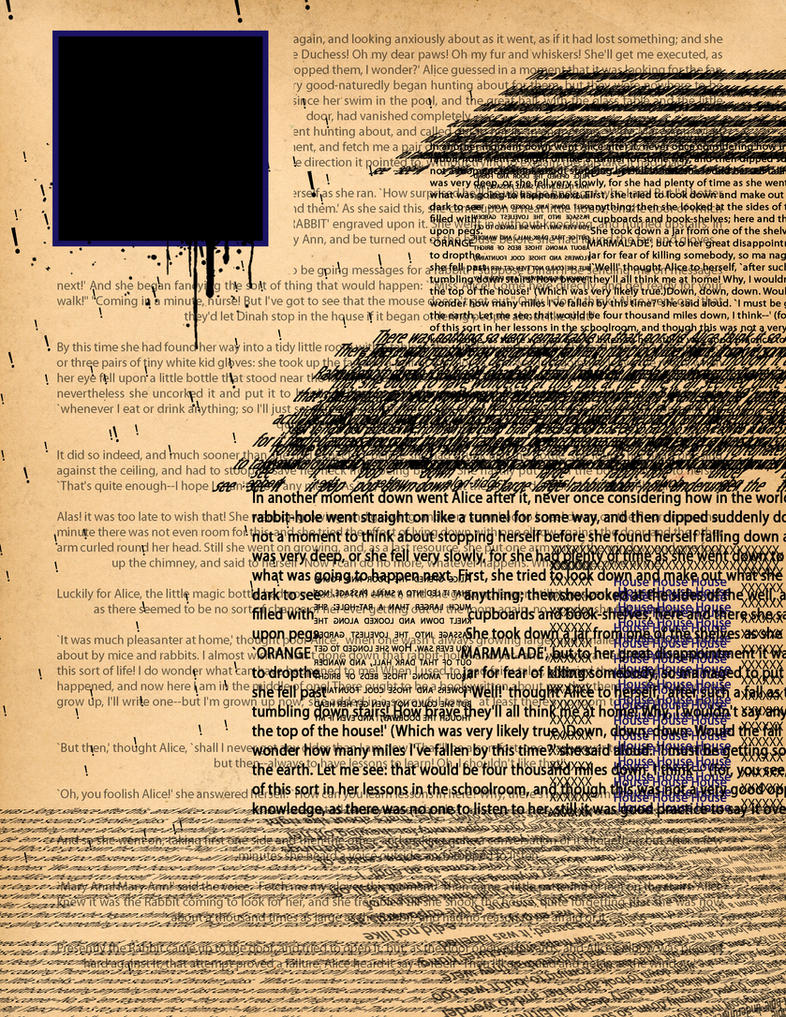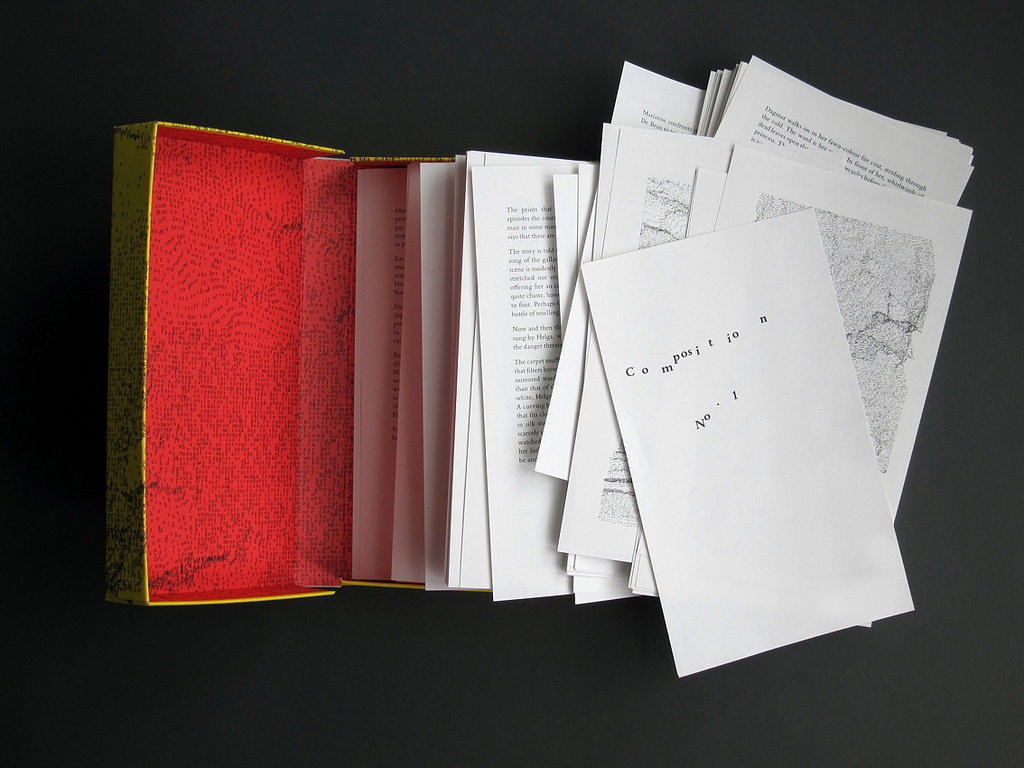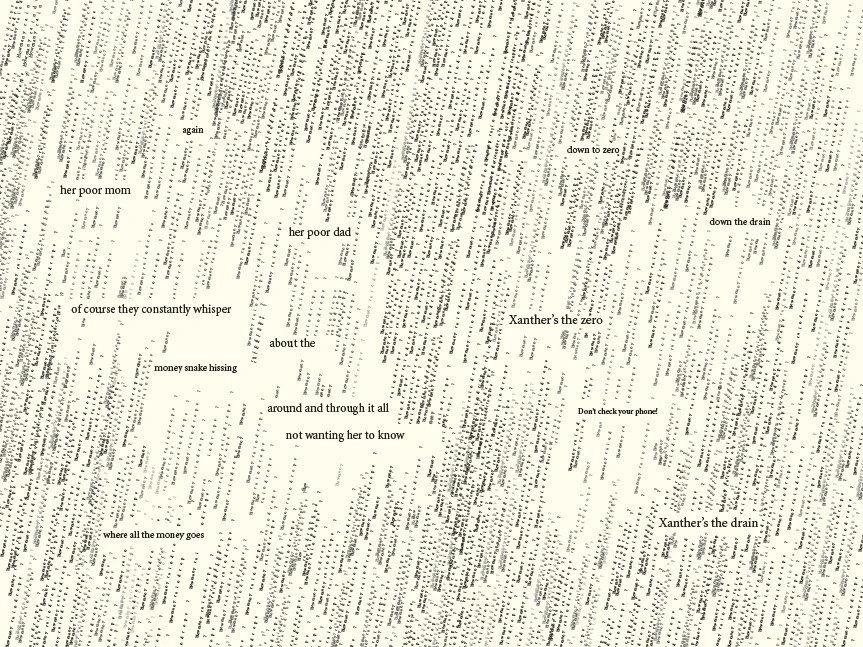The genre ergodic literature (exchange this word for experimental and you might be good) hasn’t been around for very long. There are no sections in libraries listing these types of work. And it isn’t exactly a commonly used word in the literary realm as in the realm of say, mathematics and physics. First coined by Espen J. Aarseth in Cybertext—Perspectives on Ergodic Literature (you’re just dying for a copy, right?), he described it as something which:
nontrivial effort is required to allow the reader to traverse the text. If ergodic literature is to make sense as a concept, there must also be nonergodic literature, where the effort to traverse the text is trivial, with no extranoematic responsibilities placed on the reader except (for example) eye movement and the periodic or arbitrary turning of pages.
Basically a text that requires some outside effort on the reader that is more than just turning pages to other pages and moving your eyes from top to bottom. Ok, so maybe this sounds like too much work and you may be asking the question, “Why would I want reading a book to be so much effort?”
That’s a legitimate concern. Some authors have really taken this effort to extremes and produced some really difficult works that aren’t exactly fun unless you enjoy being confused and getting possible headaches from the mind’s feeble attempt at understanding what this is all about.
At any rate, keep scrolling and stick around to get a glimpse of some of these super interesting books (some older(er) some new). House of Leaves
House of LeavesProbably one of the largest and most notable types of novels that falls into this ergodic heading. Written by Mark Danielewski and published in 2000, it is a horror/supernatural novel about a man named Johnny Truant that moves into a new apartment and finds a dead man’s manuscript, which is an extensive analysis of a film called The Navidson Record. Johnny can’t determine whether or not this film ever existed, even though the book has interviews with such people like Stephen King, claiming it is in fact real.
What really makes this book wild and scary is the subject matter of The Navidson Record. The story within the story. It’s the tale of a family who notices that their house is slowly expanding. Hallways expand and new rooms and doors appear. And one in particular is important because it leads into a huge labyrinth of a space with no light that is underneath their house. This too is constantly growing, changing and twisting.
This thing is really crazy. The text and layout of the book is not your typical Jane Eyre. But don’t take my word for it. Check it out. (Available in the RPL catalog!)
Composition No. 1
 You won’t find many books like this one by French writer Marc Saporta. It’s a republished and redesigned book from his 1962 release of the same title, which looked drastically different than the one out now. It’s a romance, technically speaking. But none of the pages are bound. It’s just a book in a box. The pages are meant to be taken out and shuffled around. The reader has total control of the layout of the story, when it begins and when it ends, making the possibility of new outcomes (the book has 155 pages) exactly:
You won’t find many books like this one by French writer Marc Saporta. It’s a republished and redesigned book from his 1962 release of the same title, which looked drastically different than the one out now. It’s a romance, technically speaking. But none of the pages are bound. It’s just a book in a box. The pages are meant to be taken out and shuffled around. The reader has total control of the layout of the story, when it begins and when it ends, making the possibility of new outcomes (the book has 155 pages) exactly:
3172584633579321477639841069678484752794561914686870082617624739168734739370962626819493040115736340593469665236817660493335696346680816787538906436385111528803020564482896297712615788185835168853807690115788778318073518854213471131681410150923560119148504437475591604658729421259630411541580627637730571688479130898485891520977020263671875.
Basically this is the only book you ever need to buy and read for your ENTIRE LIFE.
(There is even a British library that tried to actually contain this non-linear oddity and bound it for use in the library. Blasphemy or just a way so patrons don’t lose the pages? You call it.)
Tree of Codes
The author of this one is Jonathan Foer. This didn’t get quite the attention of some of his others like Everything is Illuminated and Extremely Loud and Incredibly Close, but once you see it, it quickly becomes one of his most memorable. Tree of Codes was created by taking Bruno Schulz’s book Street of Crocodiles and omitting words and sentences to create an entirely new story. Instead of just assembling the new text, the pages are actually published with the words literally cut from the page. How cool! (as long as you don’t end up tearing it) The original story is about a small Jewish family of merchants that reads more like a dream or something you might find from the likes of Murakami. You can expect ToC to be even more dreamy and poetic.
 The Familiar Vol 1: One Rainy Day in May
The Familiar Vol 1: One Rainy Day in MayAnother by Mark Danielewski clocking in over 800 pages. And this first installment is just one of the 3 that are currently out right now, all of equal length. Allegedly this is the beginning of a 27 book series. Yeah, 27 books all over 800 pages. Between this and Composition No. 1 you might have to quit your job and set a reminder to feed your cat because, well...so long free time. The book is an interwoven story taking place in one day, with many different narratives all weaved into one, with the focus mainly on a young girl named Xanther who finds a cat. Like House of Leaves it has many of the same mind-bending page layout antics that Danielewski is so good at creating. Too much to even say about this one, really. Get off your seat and get a copy (well, it’s very much possible to do that now without ever leaving your seat).
Kapow!
 A book not totally unlike some of Danielewski’s work: dizzying sideways/upside-down/slanted text with a story about an author trying to write a book. Full of details that border real life truth or complete fiction but there’s enough of a clear story with this one that the reader can stay engaged and not get burnt out from flipping the book around in circles. This novel is a tale of an author trying to write his next piece and eventually lands some inspiration to write an Arabic love story based through a friendship he develops with a local taxi driver. Lots of strange typography and line structures (of course) run through this book. In fact, so much that Adam Thirwell admitted that part of his point in doing all this was to create a reading experience “...that aged you.” Fun for some, probably not for all.
A book not totally unlike some of Danielewski’s work: dizzying sideways/upside-down/slanted text with a story about an author trying to write a book. Full of details that border real life truth or complete fiction but there’s enough of a clear story with this one that the reader can stay engaged and not get burnt out from flipping the book around in circles. This novel is a tale of an author trying to write his next piece and eventually lands some inspiration to write an Arabic love story based through a friendship he develops with a local taxi driver. Lots of strange typography and line structures (of course) run through this book. In fact, so much that Adam Thirwell admitted that part of his point in doing all this was to create a reading experience “...that aged you.” Fun for some, probably not for all.
This should be a good starting point for any of you folks out there interested in reading some of this experimental lit. But it wouldn’t be right to mention all these physical texts without mentioning some digital texts (yeah, the other half to this movement is the electronic literature side(e-lit tends to be very interactive, full of links (which depending on what sets of links you follow determines the story’s outcome), images and intentional glitches that make the stories really immersive and fun to read)).
Happy reading!



2 comments:
Thanks for reminding me that I need to go home and find my copy of B.S.Johnson's The Unfortunates.
We at the blog are happy to be of service.
Post a Comment